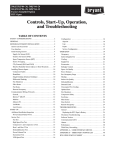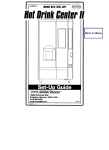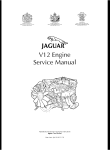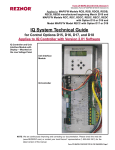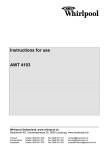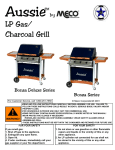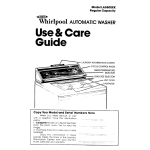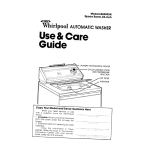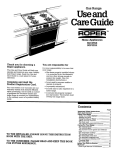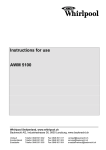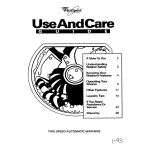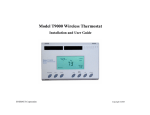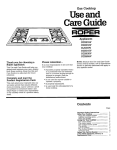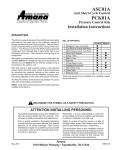Download Roper AL3132W Washer User Manual
Transcript
Washers Useand CareGuide rnTM Home Appliances AL2121W AL3132W Thank you for choosing a Roper appliance. Please complete all of the Installation Instruction This Use and Care Guide will help you operate and maintain your new, qualitybuilt automatic washer. Keep this Use and Care Guide in a safe place for future reference. Complete the form below. Have this information ready if you need service or call with a question. . Copy model and serial numbers from plate (see diagram on page 3) and purchase date from sales slip. . Keep this book and sales slip together in a handy place. steps before attempting to operate your washer. Model Number Serial Number Purchase Service Date Company Phone Number You are responsible for It is your responsibility to be sure that your washer: l Is properly installed by a qualified person.* . Is installed and leveled on a floor that can support the weight of the washer.* . Is properly connected to a grounded electrical circuit that meets the electrical requirements.* . Is properly connected to a water supply and drain. * . Is used only for the job it was designed to do. . Is not used by children or anyone unable to operate it properly. . Is protected from the weather and installed where the temperature will not fall below freezing. . Is properly maintained.* *SeeInstallation Instructions for complete information. Contents Important Safety Instructions Energy Saving Tips Before You Wash Special Model Features Sort the load Load the washer Using Your Washer AL2121W lame canacitv. single-speed‘tvasher AL3132W large capacity, single-speed washer Other Features Rinse and spin Drain and spin Manual-clean lint filter Laundry Load Guide Common Washing Problems Laundry Tips Caring For Your Washer Before leaving on vacation To protect your washer from freezing _ Before You Call For Service Warranty How to get service or assistance 9 :i 10 :; 12 Important Safety Instructions Reduce risk of fire, electrical shock, or personal injury when using your washer, by following basic precautions, including the following: . Read all instructions before using your washer. . DO NOT wash items cleaned in, washed in, soaked in or spotted with gasoline, dry-cleaning solvents, paint, wax or other flammable or explosive substances in the washer. The fumes can create a fire or explosion. Always handwash and air-dry fabrics containing these materials. . DO NOT allow children to play on or inside the washer. Close supervision of children is necessary when the washer is used near them. . Before the washer is removed from service or discarded, remove the lid to prevent accidental entrapment. . DO NOT reach into the washer basket while it is filling with water, while agitator is moving or while basket is spinning. If the lid is opened while the basket is spinning, the basket will automatically stop in a few seconds. . DO NOT install or store washer where it will be exposed to the weather. . DO NOT tamper with controls. . You are responsible for making sure that your washer is installed, repaired and has parts replaced by a qualified person. . DO NOT add gasoline, dry-cleaning solvents or other flammable or explosive substances to the wash water. The substances give off vapors that could ignite or explode. n If hot water has not been used recently (usually 2 weeks or longer), hydrogen gas may build up in the water heater and the hot water pipes. HYDROGEN GAS IS EXPLOSIVE. To prevent injury or damage, before using your washer, turn on all hot water faucets and allow water to run for several minutes. This will allow gases to escape. DO NOT smoke or use any open flame near the faucet while it is open. .SAVE THESE INSTRUCTIONS. Energy Saving Tips 1. Use washer during non-peak energy usage hours. (Contact your power company for the most energy-efficient times.) 2. Use hot water only when washing whites or heavy or greasy soils. 3. Use cold water for washing light soils. 4. Use cold rinses. 5. Adjust the water level when washing small loads. 6. Avoid rewashing by: - pretreating stains or heavy soils; - properly sorting clothes; - using enough detergent; - not overloading; - using proper cycles and wash times. Page 2 Before You Wash 1. Turn all pockets inside out and empty. 2. Turn down cuffs. Brush away lint and dirt. 3. Close zippers, snaps and hooks and remove pins, buckles and other hard objects to prevent scratching laundry basket, agitator or snagging other items. 4. Remove unwashable trim and ornaments. 5. Tie strings and sashes to prevent tangling. 6. Mend tears, loose hems and seams. 7. Treat spots and stains. Pre-soak if necessary. n n n n n n The washer must be electrically grounded. SeeInstallation Instructions. Store detergent and laundry products in a cool, dry place out of children’s reach. A locked cabinet is recommended. Read and follow instructions on detergent and laundry packages. Pay special attention to warnings and precautions. DO NOT use chlorine bleach in the same wash as ammonia, vinegar, rust remover or other acids. Hazardous fumes can form. DO NOT machine-wash glass fiber materials. Small particles can stick to fabrics washed in following loads and cause skin irritation. DO NOT use or store dry-cleaning solvents, kerosene or other flammable or explosive substances in or near your washer. These substances give off vapors that can create a fire hazard or explosion. Special Model Features Cycle control knob Water level selector (AL3132W) Model and serial number plate (under lid) Agitator Manual-clean lint filter (AL3132W-not shown) Tub The drawings in this book may vary slightly from your washer model. They are designed to show the different features of all the models covered by this book. Your model may not include all the features shown. Sort the load Sort items by lint-givers (chenille, bath towels) and lint-takers (corduroy, permanent press and synthetics). Sort by fabric and construction (cottons, knits and delicate items). Sort by color (white, colorfast and noncolorfast). Sort by amount of soil (heavy, normal and light). Laundry Tip DO NOT overload washer. Overloading or packing can cause poor cleaning, increased wrinkling, excessive lint and can wear out items faster. Use highest water level for the best permanent press results. Load the washer Drop items into washer loosely and evenly. For best cleaning and wrinkle-free results, items should move freely in wash water. Permanent press and synthetic knits should have more room to move in the water than towels, jeans, etc. (For specific loading recom- mendations see page 6.) Page 3 Set cycle, water temperature and wash time To start To change load size Pull cycle control knob out. The washer will fill to the selected water level and water temperature. Immediately after filling, the washer will agitate for a selected number of minutes. Agitation can occur with the washer lid up or down. The washer will pause briefly throughout each cycle. These pauses are normal for washer operation, The washer will automatically fill for highest water level when cycle control knob is turned to 14 or 10 minutes in the REGULARHEAVY Cycle, or to 6 minutes in the SHORTCycle. For smaller load sizes (and a lower water fill), follow these steps: 1. Push cycle control knob in and turn clockwise to 14 minutes (for hot water) or 10 minutes (for warm water) in the REGULARHEAVY Cycle. 2. Pull cycle control knob out. The washer will start to fill. 3. When the washer reaches the desired water level, push cycle control knob in and turn clockwise until it points to 6 minutes in the REGULARHEAVY Cycle. 4. Pull out cycle control knob to start the washer. To stop at any time Water temperature and load size are selected through wash time. . Hot water can be selected by turning cycle control knob to 14 minutes in the REGULARHEAVY Cycle. Rinses are cold. . Warm water can be selected by turning cycle control knob to 10 minutes in the REGULARHEAVY Cycle, or to 6 minutes in the SHORT Cycle. Rinses are cold. Push in cycle control knob and turn it clockwise. Stop when indicator on knob’s outer ring points to the number in the wash cycle you want. The numbers are minutes of wash time. Wash cycles Regular Heavy (14 min.) Wash sturdily constructed fabrics (i.e. cotton) or heavily soiled items. Regular Heavy (10 min.) Wash moderately soiled fabrics. Short (6 min.) Gently wash lightly soiled delicates and washable knits. NOTE: Use shorter wash times for lightly soiled loads. Loads with only a few small items need less wash time for best results. Page 4 Push cycle control knob in. To restart, pull cycle control knob out. Laundry Tip For best cleaning results, use: -Hot wash water for normally soiled, permanent press and synthetic items; white and colorfast cottons; heavy soils and diapers. -Warm wash water for knits; dark or non-colorfast colors; washable woolens; moderate soil. -Cold wash water for lightly soiled fabrics; some non-colorfast colors. Dry detergents can spot-fade wet laundry. If using cold water, dissolve recommended amount of detergent in one quart (1 L) of warm water before adding it to the washer, or use a liquid detergent, Select water level Select cycle and water temperature Select wash time To set the correct water level, turn the water level selector knob to the level that describes the size of your wash load. The water level can be set to SMALL (a few small items) or LARGE (a full load). NOTE: For best results with permanent press clothes, use the LARGE water level. Reduce wash time when using the SMALL water level setting. Loads with only a few small items need less wash time for best results. To set the water temperature, push in the cycle control knob and turn it clockwise to the area marked H (hot), W (warm) or C (cold). Set water temperature level according to fabric label or the amount of soil to be washed. NOTE: All rinses use cold water. Start the washer by pulling out cycle control knob. The washer will fill to the level you set with wash water of the selected temperature. After filling, stop Select a wash time by stopping the washer after filling. Turn cycle control knob to the number in the wash cycle you want. The numbers are minutes of wash time. Restart the washer. Wash cycles Regular Heavy (14 min.) Wash sturdily constructed fabrics (i.e. cotton) or heavily soiled items. Regular Normal (6 min.) Wash moderately soiled fabrics. Permanent Press (10 min.) Wash moderately soiled permanent press and some synthetic fabrics. Cool-down rinse helps to keep fabrics from wrinkling. Permanent Press (6 min.) Wash lightly soiled permanent press and some synthetic fabrics. Cool-down rinse helps to keep fabrics from wrinkling. the washer by pushing in cycle control knob. Select wash time Laundry Tip For best cleaning results, use: -Hot wash water for normally soiled, permanent press and synthetic items; white and colorfast cottons; heavy soils and diapers. -Warm wash water for knits; dark or non-colorfast colors ; washable woolens; moderate soil. -Cold wash water for lightly soiled fabrics; some non-colorfast colors. Dry detergents can spot-fade wet laundry. If using cold water, dissolve recommended amount of detergent in one quart (1 L) of warm water before adding it to the washer, or use a liquid detergent. To start Pull cycle control knob out. The washer will agitate for a selected number of minutes. Agitation can occur with the washer lid up or down. The washer will pause briefly throughout each cycle. These pauses are normal for washer operation. To stop at any time Push cycle control knob in. To restart, pull cycle control knob out. Page 5 Other Features Rinse and spin Drain and spin Manual-clean lint filter Complete rinsing of fabrics washed with extra detergent may require an extra rinse and spin. To set for extra rinse and spin: 1. Push cycle control knob in. 2. Turn knob clockwise to one of the dots on the dial, as illustrated above. (Seearrows in drawing.) 3. Pull cycle control knob out. The washer will fill to selected level, agitate, drain and spin. A dram and spin may help shorten drying times for some fabrics or handwashed items by removing excess water. 1. Push cycle control knob in. 2. Turn clockwise to any bar located just before an OFF area on the dial, as illustrated above. (Seearrows in drawing.) 3. Pull cycle control knob out. The washer will drain and spin. AL3132W Clean the lint filter after every load. 1. Lift up agitator barrel. 2. Wash or wipe the filter clean (located in bottom of the agitator barrel). The filter is not removable. 3. Snap the agitator back into place. NOTE: On Model AL2121W, lint is washed out with existing wash water. If your washer drams into a tub, remove any lint collected in the tub or strainer. Laundry Load Guide Use highest water level for these suggested full-size loads. Mixed Load 2 double sheets or 1 king-size sheet 4 pillowcases 6 T-shirts 6 pair shorts 2 shirts 2 blouses 6 handkerchiefs Page 6 Heavy Work Clothes 2 pair pants 3 shirts 3 pair jeans 1 coverall Towels 8 bath towels 8 hand towels 10 wash cloths 1 bathmat Permanent Press Knits Delicates 1 double sheet 1 tablecloth 1 dress 1 skirt 2 blouses 2 slacks 3 shirts 2 pillow cases 2 slacks 2 blouses 4 shirts 4 tops 2 dresses 2 camisoles 4 slips 2 panties 2 bras 2 nighties Common Washing Problems PROBLEM Dye transfer CHECK IF Load is properly sorted Load has been left in washer for extended time Gray whites, dingy colors Load is properly sorted Enough detergent is used Water is hot enough Water is too hard for soap or detergent used Greasy spots Undiluted fabric softener touches fabric Fabric softener added to wash water Enough detergent is used Soil deposits are present on basket interior or agitator Lint Load is properly sorted Load is too big for capacity or water level Paper or tissue is in pocket Enough detergent is used Pilling is being mistaken for lint Load too wet after spin Rinse is cold Lid has been opened before spinning has completed WHAT TO DO Separate colorfast from non-colorfast items. Prevent light-colored items from contacting non-colorfast items. Unload washer immediately. Separate white, colored and non-colorfast items. Increase amount of detergent. Hot water should be at least 130°F (54°C). Use liquid detergent in increased amounts for water hardness and amount of soil. Use a water conditioner in the wash and rinse. Install a mechanical water softener. Dilute fabric softeners with l/2 to 1 cup (125 to 250 mL) warm water. Add fabric softener only in rinse part of the cycle. Use enough detergent to hold soil so it drains away with wash water. Treat spots with heavy-duty liquid detergent. Wash in warm or hot water with extra detergent. Wash more than once; DO NOT dry between washings. Wipe with a damp cloth or remove deposits by running a complete cycle using hot water, 2 cups (500 mL) of detergent and 1 cup (250 mL) of chlorine bleach. Separate lint givers (towels) from lint takers (synthetics, permanent press, corduroys). Separate synthetic items from cotton items. Drop items in loosely; DO NOT pack clothes tightly into basket. Check pockets before washing. Use more detergent. Laundering raises a surface fuzz called pilling. Synthetics are more likely to pill than other fabrics. Cold rinses leave loads colder/wetter, but save money, energy and cause fewer wrinkles. Close lid firmly. Complete cycle before opening lid. Continued on next page Page 7 PROBLEM Overall yellow; brown or yellow stains WHAT TO DO CHECK IF Chlorine bleach is used Chlorine bleach can permanently yellow some fabrics. Read fabric washing label and chlorine bleach package label carefully. Iron is in water heater or pipes Run hot water a few minutes before washing to clear lines. Drain water heater occasionally. Iron or manganese is in water DO NOT use chlorine bleach in water containing iron. Use a water conditioner in wash and rinse water. Install an iron filter. Fabric is poor quality Shrinking Fabric-care label directions were followed Check fabric quality before purchasing. Follow fabric care label directions. Chlorine bleach is properly used Sharp articles are removed; fasteners are fastened Rips, broken threads and tears not mended before washing Follow chlorine bleach directions. Remove sharp objects; fasten hooks and eyes, zippers and snaps; turn synthetic fabrics inside out before washing. Mend fabric before washing. Stiff, harsh fabrics [usually cottons) Water is too hard for soap or detergent used Cottons are line-dried Use proper amount of detergent for water hardness. Do not use soap if you have hard water. Dry cottons in dryer. Twisting tangling Load too big for washer capacity or water level Items are improperly loaded Use proper load and water level. Snags, rips, holes or DO NOT wrap items around the agitator. DO NOT slip straps over agitator. Wrinkling Load is too big for washer capacity Drop items in loosely; DO NOT pack clothes tightly into basket. Wash or water level smaller loads of synthetic and permanent press items. Setting allows for cool-down time Use Permanent Press Cycle (AL3132W). This cycle includes a cool-down of the wash water before the spin. Load has been left in washer or Unload washer or laundry basket immediately. laundry basket for extended time NOTE: Since permanent press finishes may vary, items labeled “Permanent Press” may require touch up ironing. Yellow areas Make sure water is hot (at least 130”F/54”C). Body oils may have stained fabric-usually found on the middle of pillowcases and sheets; Increase the amount of detergent. underarms of cotton clothing Page 8 Laundry Tips Stained or wet garments should be washed promptly. Dry laundry immediately after washing to prevent wrinkling. For best results when using soap, detergent, chlorine or all-fabric bleach, fabric softeners, pretreatment or enzyme laundry products, packaged water conditioners, bluing, ammonia or starch, follow the package instructions. Water hardness Many poor washing results can be traced to wash water hardness. To check your water hardness __. . City water-ask your city water company. . Well water-call your Cooperative Extension Service. Ask for the mineral content in grainsper-gallon or parts-per-million. If your water is 9 or more grains-per-gallon or more than 153 parts-per-million: . Consider installing a water softener. . Use more detergent. . Use a packaged water conditioner. . Do Not use soap. Fabric softeners . Always dilute fabric softeners with l/2 to 1 cup (125 to 250 mL) warm water. Undiluted fabric softener can stain fabrics. . Add fabric softener after the washer fills for the rinse part of the cycle. (Seearrows in the illustration under “Rinse and spin” on page 6.) Use liquid fabric softener only in the rinse part of the cycle. . Fabric softeners should not be mixed with other laundry products. . Too much fabric softener can make some items non-absorbent (diapers and towels). If this happens, use less fabric softener or do not use it every time. Soaking Tints and dyes When soaking in your washer: . Always use detergent. . If using chlorine bleach, also add detergent. n Vinegar or other acids should not be used in your washer because acids attack all porcelain basket finishes and can reduce the life of your washer. . Use only products labeled as being washer safe. Follow package directions for tints and dyes. . When you are finished 1. Put chlorine bleach and detergent in the washer. 2. Run through a complete cycle using hot water. 3. Repeat if staining occurs on following loads. NOTE: Washer parts such as agitator, washer lid, etc. can be stained by the dye color. n Stain removal guide I Fire Hazard . Never put dry-cleaning solvents or fluids directly into your washer. . Never put items treated with solvents in your washer until they have been completely rinsed and air dried. The fumes from these solvents can create a fire or explosion. . Treat stains when they are fresh. Old or set stains may not come out. mBefore treating, check: -type of stain. - fabric label and how colorfast it is. - how old the stain is. . Use cold or warm water first. Hot water can set some stains. . Use a bleach that is safe for the garment. Dilute chlorine bleach. . Test stain remover products on inside seam or hidden corner of item to check colorfastness. . Put stained area face down on paper towel or white cloth. Apply stain remover to back of stain to force the stain off the fabric instead of through it. . Use meat tenderizer or enzyme presoaks for easier removal of some protein stains. 1 Use dry cleaning solvents in a well ventilated room. . For specific stain removal recommendations, ask your Cooperative Extension Service Office or consult a public utility home economist. Page 9 Caring For Your Washer To keep your washer looking like new: . Wipe up detergent, bleach or other spills with a soft, damp cloth as they occur. . Sharp or heavy objects should not be put on or in your washer. Check pockets for nuts, bolts, etc. . If the washer interior needs cleaning, put 1 cup of chlorine bleach and 2 cups of detergent in the washer. Run through a complete cycle using hot water. . When removing hard water deposits, use only cleaners labeled as being washer safe. Before leaving on vacation 1. Shut off both water faucets. 2. Unplug power cord and turn off electric power supply. To protect your washer from freezing Install and store your washer where it won’t freeze. Because some water stays in the washer, freezing can damage it. If your washer is stored or moved during freezing weather, winterize it. 1. Shut off both water faucets. 2. Disconnect and drain water inlet hoses. 3. Put a quart of R.V.-type antifreeze in the washer basket. 4. Push cycle control knob in. Turn knob clockwise to just beyond any dot on the dial. See “Rinse and spin” on page 6 for additional information. 5. Pull knob out, and allow washer to run for about 30 seconds to mix antifreeze and water. 6. Unplug power cord and turn off electric power supply. 7. Store where washer will not freeze. To use washer again 1. Flush water pipes and hoses. 2. Reconnect water inlet hoses according to Installation Instructions. 3. Open both water faucets. 4. Plug power cord into electrical outlet. 5. Clean out antifreeze by adding one cup of detergent to basket and running washer through a complete cycle. Page 10 Before You Call For Service If you are having an operating problem, check this chart to see what might be the cause before you caIl for assistance. IPERATING PROBLEM Washer will not fill. . Power cord is plugged into a live circuit with proper voltage. . Household fuse has blown or circuit breaker has tripped. Check if time-delay fuse has been used. . Both hot and cold water faucets are open. . Water supply hoses are kinked. . Cycle control knob is set and pulled out. Washer does not spin. . Lid is closed. . Power cord is plugged into a live circuit with proper voltage. . Household fuse has blown or circuit breaker has tripped. Check if time-delay fuse has been used. Washer stops during a cycle. WHAT TO DO CHECK IF . Washer pauses briefly at different times in each cycle. These pauses are normal. . Power cord is plugged into a live circuit with proper voltage. . Household fuse has blown or circuit breaker has tripped. Check if time-delay fuse has been used. Washer fills and drains without running. . Cycle control knob is pointing to a number in the cycle. Washer drains during wash and rinse cycles or water siphons out. . Drain hose is higher than the water level in the washer. . Firmly plug power cord into electrical outlet. Check circuit voltage at your home’s fuse/circuit breaker box. . Replace fuse with a time-delay fuse of the correct capacity. Reset circuit breaker. n Open both faucets. n Straighten hoses. I Set cycle control knob and pull out firmly. Close lid firmly. Firmly plug power cord into electrical outlet. Check circuit voltage at your home’s fuse/circuit breaker box. I Replace fuse with a time-delay fuse of the correct capacity. Reset circuit breaker. n n m Wait a minute to see if washer starts cycle again. Firmly plug power cord into electrical n outlet. Check circuit voltage at your home’s fuse/circuit breaker box. I Replace fuse with a time-delay fuse of the correct capacity. Reset circuit breaker. n n Set cycle control knob on correct number in the cycle. Adjust dram hose so that it is higher than the water level in the washer. Page 11 LIMITED WARRANTY ROPERT” Home Appliances PRODUCTS COVERED WHAT WE WILL PAY FOR FULL ONE YEAR WARRANTY All Roper Appliances Replacement parts and repair labor to correct defects in materials or workmanship. FULL FIVE YEAR WARRANTY Refrigerators Freezers Air Conditioners Dehumidifiers Replacement parts and repair labor for the sealed refrigeration system (compressor, evaporator, condenser, drier or connecting tubing) which we find to be defective in materials or workmanship. LIMITED 2ND-5TH WARRANTY YEAR Microwave Ovens Repair or replacement of magnetron tube which we find to be defective in materials or workmanship. LIMITED 2ND-5TH WARRANTY YEAR Automatic Washers Repair or replacement of any part of the gear case assembly which we find to be defective in materials or workmanship. LENGTH OF WARRANTY (From date of purchase) WHAT WE WILL NOT PAY FOR A. SERVICECALLS TO: 1. Correct the installation of your appliance. 2. Instruct you how to use your appliance. 3. Replace house fuses or correct house wiring or plumbing. 4. Replace owner accessible light bulbs. B. Repairs when appliance is used in other than normal, single-family household use. C. Pick up and delivery. Your appliance is designed to be repaired in the home. D. Damage to appliance caused by accident, misuse, fire, flood, acts of God, or use of product not approved by us. E. Any labor costs during the limited warranties. This Roper appliance is warranted by Whirlpool Corporation. Under no circumstances shall it be liable under this warranty for incidental or consequential damages and all implied warranties are limited to the same time periods stated in the express warranties for Roper Brand Appliances. Some states do not allow the exclusion or limitation of incidental or consequential damages or limitations of how long an implied warranty may last, so the above limitations or exclusions may not apply to you. This warranty gives you specific legal rights, and you may also have other rights which vary from state to state. Outside the United States, a different warranty may apply. For details, please contact your franchised Roper distributor or military exchange. HOW TO GET SERVICE OR ASSISTANCE If you need service, first see the “Before You Call For Service” section of this book. If you still need service after checking this section, additional help can be found if you: . Contact your selling dealer for the authorized servicer in your area? OR .Phone l-800-44-ROPER (l-800-447-6737) between 8:00 a.m. and 4:30 p.m. Eastern Time, Monday through Friday’: OR .For further information, write to: Consumer Relations Dept., Roper Brand Appliances, 2000 M-63 North, Benton Harbor, MI 49022: *When requesting assistance, please provide the model and serial numbers, date of purchase, and a complete description of the problem. The model and serial numbers are located on a plate under the lid (see illustration on page 3). If you are not satisfied with the service received, contact the Major Appliance Consumer Action Panel (MACAP). MACAP is a group of independent consumer experts that voices consumer views at the highest levels of the major appliance industry. Contact MACAP only when the dealer, authorized servicer or Roper Brand warrantor have failed to resolve your problem: Major Appliance Consumer Action Panel 20 North Wacker Drive Chicago, IL 60606 MACAP will in turn inform us of your action. Part No. 3355695Rev. A 01991 Whirlpool Corporation TM Trademark of Whirlpool Corporation Printed in U.S.A.












